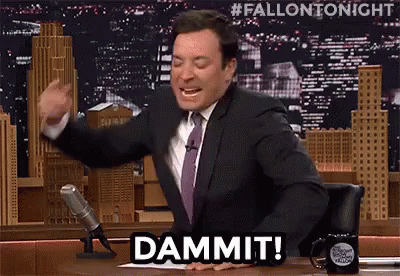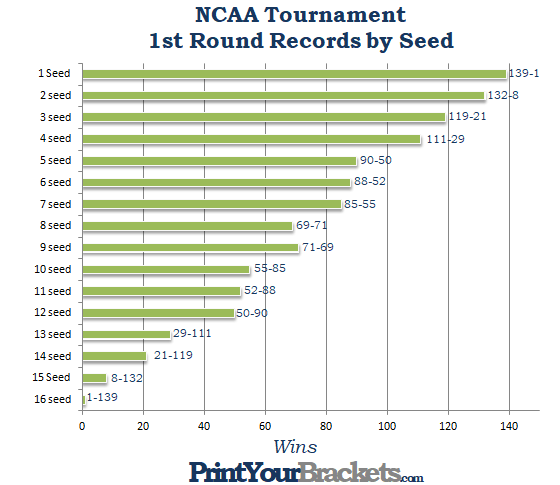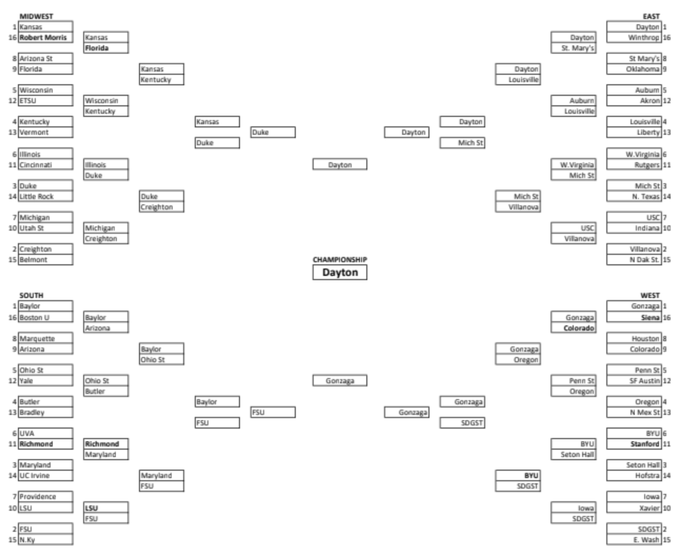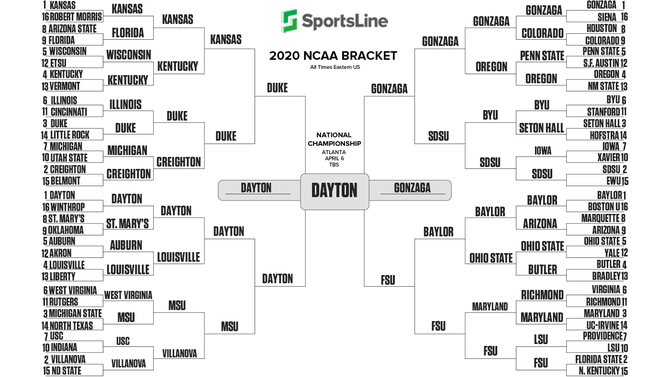NCAA Tournament – Quantitative Reference Thread
39 posts
• Page 3 of 4 • 1, 2, 3, 4
Re: NCAA Tournament – Quantitative Reference Thread
.
(4) Saturday Big East Early Afternoon Games 2/1/20 – Post # 19
This classic by adoraz earned a place in the NCAA Tournament – Quantitative Reference Thread Hall of Fame.
-----------------------------------------------------------------------------------------------------------------------------------------------------------------------------------------------
Big East Conference Detailed Standings – ESPN
The surprising results of this afternoon’s games suggests that a serious logjam in the middle of the Big East pack is now a distinct possibility.
For example, #16 Butler (5-4) is now tied with Providence (5-4) for fifth place in the Big East Standings. Expect more carnage in the weeks ahead.
At the bottom of the second post on this thread, you can find links to articles relevant to this situation.
(4) Saturday Big East Early Afternoon Games 2/1/20 – Post # 19
On February 1, 2020 adoraz wrote:Fieldhouse Flyer wrote:
NCAA Tournament – Quantitative Reference Thread
Listing of NCAA Tournament At-large Selections Under .500 in Conference Play - CBS SPORTS NCAA TOURNAMENT HISTORY
No team with a 7-11 conference record has ever received an NCAA Tournament At-large invitation.
I'm pretty sure 7-11 teams and even one 6-12 team (Georgia around 2000) have received at large bids.
This classic by adoraz earned a place in the NCAA Tournament – Quantitative Reference Thread Hall of Fame.
-----------------------------------------------------------------------------------------------------------------------------------------------------------------------------------------------
Big East Conference Detailed Standings – ESPN
The surprising results of this afternoon’s games suggests that a serious logjam in the middle of the Big East pack is now a distinct possibility.
For example, #16 Butler (5-4) is now tied with Providence (5-4) for fifth place in the Big East Standings. Expect more carnage in the weeks ahead.
At the bottom of the second post on this thread, you can find links to articles relevant to this situation.
Dayton Flyers . . . UD Fieldhouse (1950 – 1969) . . . UD Arena (1969 – Present) . . . Transform UD Arena
-

Fieldhouse Flyer - Posts: 1389
- Joined: Tue Apr 01, 2014 5:11 am
Re: NCAA Tournament – Quantitative Reference Thread
.
More Quantitative References from the Division I Men’s Basketball homepage – NCAA.com
2020 NCAA tournament: Top 16 reveal date, time, TV channel, what to know - NCAA.com – February 8, 2020
Top-16 teams revealed in NCAA committee's first in-season look at 2020 March Madness bracket - NCAA.com – February 8, 2020
More Quantitative References from the Division I Men’s Basketball homepage – NCAA.com
2020 NCAA tournament: Top 16 reveal date, time, TV channel, what to know - NCAA.com – February 8, 2020
In-season Top 16: Where do they end up?
In the first two years of the in-season reveal, there weren't many big shakeups by the time of Selection Sunday. Most teams either remained the same seed or moved up or down a seed or two.
The 2017-18 Oklahoma team had been a No. 4 seed in the in-season top 16 announcement, but OU went on a 4-10 slide going into the NCAA tournament — and got a No. 10 seed. The Sooners lost to Rhode Island in the first round.
Last year saw the final five teams in the in-season top 16 all drop on the seed lines, including Nevada and Louisville falling from No. 4 to No. 7 seeds. All five of these teams lost in the first round of the NCAA tournament.
YEAR • TEAM • IN-SEASON SEED (OVERALL) • NCAAT SEED (OVERALL) • CHANGE (IN SEED)
2017 Villanova 1 (1) 1 (1) 0
2017 Kansas 1 (2) 1 (2) 0
2017 Baylor 1 (3) 3 (12) Down 2
2017 Gonzaga 1 (4) 1 (4) 0
2017 North Carolina 2 (5) 1 (3) Up 1
2017 Florida State 2 (6) 3 (10) Down 1
2017 Louisville 2 (7) 2 (8) 0
2017 Oregon 2 (8) 3 (9) Down 1
2017 Arizona 3 (9) 2 (6) Up 1
2017 Virginia 3 (10) 5 (17) Down 2
2017 Florida 3 (11) 4 (14) Down 1
2017 Kentucky 3 (12) 2 (5) Up 1
2017 Butler 4 (13) 4 (13) 0
2017 West Virginia 4 (14) 4 (16) 0
2017 UCLA 4 (15) 3 (11) Up 1
2017 Duke 4 (16) 2 (7) Up 2
--------------------------------------------
2018 Virginia 1 (1) 1 (1) 0
2018 Villanova 1 (2) 1 (2) 0
2018 Xavier 1 (3) 1 (4) 0
2018 Purdue 1 (4) 2 (7) Down 1
2018 Auburn 2 (5) 4 (13) Down 2
2018 Kansas 2 (6) 1 (3) Up 1
2018 Duke 2 (7) 2 (6) 0
2018 Cincinnati 2 (8) 2 (8) 0
2018 Clemson 3 (9) 5 (19) Down 2
2018 Texas Tech 3 (10) 3 (12) 0
2018 Michigan State 3 (11) 3 (9) 0
2018 North Carolina 3 (12) 2 (5) Up 1
2018 Tennessee 4 (13) 3 (10) Up 1
2018 Ohio State 4 (14) 5 (20) Down 1
2018 Arizona 4 (15) 4 (16) 0
2018 Oklahoma 4 (16) 10 (40) Down 6
--------------------------------------------
2019 Duke 1 (1) 1 (1) 0
2019 Tennessee 1 (2) 2 (5) Down 1
2019 Virginia 1 (3) 1 (2) 0
2019 Gonzaga 1 (4) 1 (4) 0
2019 Kentucky 2 (5) 2 (7) 0
2019 Michigan 2 (6) 2 (8) 0
2019 North Carolina 2 (7) 1 (3) Up 1
2019 Michigan State 2 (8) 2 (6) 0
2019 Purdue 3 (9) 3 (12) 0
2019 Kansas 3 (10) 4 (13) Down 1
2019 Houston 3 (11) 3 (9) 0
2019 Marquette 3 (12) 5 (17) Down 2
2019 Iowa State 4 (13) 6 (24) Down 2
2019 Nevada 4 (14) 7 (26) Down 3
2019 Louisville 4 (15) 7 (25) Down 3
2019 Wisconsin 4 (16) 5 (19) Down 1
Top-16 teams revealed in NCAA committee's first in-season look at 2020 March Madness bracket - NCAA.com – February 8, 2020
The Top 16 teams were assigned to regions as follows:
South (Houston): (1) Baylor, (2) Louisville, (3) Seton Hall, (4) Auburn
Midwest (Indianapolis): (1) Kansas, (2) Dayton, (3) Florida St., (4) Michigan St.
West (Los Angeles): (1) Gonzaga, (2) West Virginia, (3) Villanova, (4) Oregon
East (New York City): (1) San Diego St., (2) Duke, (3) Maryland, (4) Butler
NCAA Division I Men's Basketball Committee's Top 16 (Feb. 8, 2020):
RANK • SCHOOL • RECORD
1 Baylor 20-1
2 Kansas 19-3
3 Gonzaga 24-1
4 San Diego State 23-0
5 Duke 19-3
6 Dayton 20-2
7 Louisville 20-3
8 West Virginia 18-4
9 Maryland 19-4
10 Florida State 19-3
11 Seton Hall 17-5
12 Villanova 17-5
13 Auburn 20-2
14 Oregon 18-5
15 Butler 18-5
16 Michigan State 16-7
Dayton Flyers . . . UD Fieldhouse (1950 – 1969) . . . UD Arena (1969 – Present) . . . Transform UD Arena
-

Fieldhouse Flyer - Posts: 1389
- Joined: Tue Apr 01, 2014 5:11 am
Re: NCAA Tournament – Quantitative Reference Thread
.
Division I Men's Basketball homepage – NCAA.com . . . . . OFFICIAL NCAA NITTY-GRITTY REPORT ARCHIVE – NCAA.org
OFFICIAL NCAA NITTY-GRITTY REPORT (through games of March 3, 2020) – NCAA.org
The 2020 Bracket Matrix - bracketmatrix.com – updated March 3, 3030
Observations:
1. As of today, most Bracketologist are giving #1 seeds to Baylor, Gonzaga, and San Diego State.
2. Last year, the worst SOS Ranking for any of the NET Top 4 teams was 52 • Gonzaga (NET Ranking #2).
3. I strongly suspect that if Baylor, Gonzaga, and San Diego State played SOS Top 30 schedules this season (as 7 of the 10 Big East teams have so far), none of these three teams would be in the conversation for a #1 seed.
4. I also strongly suspect that if Seton Hall, Creighton, and Villanova played the schedules of Baylor, Gonzaga, and San Diego State, these three Big East teams would be strong contenders for a # 1 seed this year.
But we’ll never know.
Division I Men's Basketball homepage – NCAA.com . . . . . OFFICIAL NCAA NITTY-GRITTY REPORT ARCHIVE – NCAA.org
On January 17, 2020 Fieldhouse Flyer wrote:
OFFICIAL NCAA NITTY-GRITTY REPORT (through games of March 17, 2019) – NCAA.org
Teams sorted by NET Ranking
SOS Ranking • Team • NET Ranking
26 • Virginia • 1
52 • Gonzaga • 2
2 • Duke • 3
32 • Houston • 4
OFFICIAL NCAA NITTY-GRITTY REPORT (through games of March 3, 2020) – NCAA.org
Teams sorted by NET Ranking
SOS Ranking • Team • NET Ranking
1 • Kansas • 1
133 • Gonzaga • 2
24 • Dayton • 3
106 • San Diego State • 4
72 • Baylor • 5
23 • Duke • 6
39 • Michigan State • 7
31 • Louisville • 8
35 • BYU • 9
3 • Arizona • 10
36 • Florida State • 11
15 • Seton Hall • 12
28 • Creighton • 13
4 • Villanova • 14
52 • Butler • 20
7 • Marquette • 26
12 • Xavier • 41
10 • Providence • 44
18 • Georgetown • 62
67 • UConn • 64
47 • St. John's • 66
67 • DePaul • 81
---------------------------------------------------------------------
Teams Sorted by SOS Ranking (Same nunbers as above.)
SOS Ranking • Team • NET Ranking
1 • Kansas • 1
3 • Arizona • 10
4 • Villanova • 14
7 • Marquette • 26
10 • Providence • 44
12 • Xavier • 41
15 • Seton Hall • 12
18 • Georgetown • 62
23 • Duke • 6
24 • Dayton • 3
28 • Creighton • 13
31 • Louisville • 8
35 • BYU • 9
36 • Florida State • 11
39 • Michigan State • 7
47 • St. John's • 66
52 • Butler • 20
67 • UConn • 64
67 • DePaul • 81
72 • Baylor • 5
106 • San Diego State • 4
133 • Gonzaga • 2
The 2020 Bracket Matrix - bracketmatrix.com – updated March 3, 3030
Observations:
1. As of today, most Bracketologist are giving #1 seeds to Baylor, Gonzaga, and San Diego State.
2. Last year, the worst SOS Ranking for any of the NET Top 4 teams was 52 • Gonzaga (NET Ranking #2).
3. I strongly suspect that if Baylor, Gonzaga, and San Diego State played SOS Top 30 schedules this season (as 7 of the 10 Big East teams have so far), none of these three teams would be in the conversation for a #1 seed.
4. I also strongly suspect that if Seton Hall, Creighton, and Villanova played the schedules of Baylor, Gonzaga, and San Diego State, these three Big East teams would be strong contenders for a # 1 seed this year.
But we’ll never know.
Dayton Flyers . . . UD Fieldhouse (1950 – 1969) . . . UD Arena (1969 – Present) . . . Transform UD Arena
-

Fieldhouse Flyer - Posts: 1389
- Joined: Tue Apr 01, 2014 5:11 am
Re: NCAA Tournament – Quantitative Reference Thread
By pure coincidence, less than 24 hours after I submitted the post above, USA Today published this article:
2020 NCAA Tournament Bracketology: Dayton rises to No. 1 seed, replacing San Diego State - USA Today - March 5, 2020
While accepting that my opinion may be biased, I still think Gonzaga is presently over-rated by the various Bracketologists. Here’s why:
OFFICIAL NCAA NITTY-GRITTY REPORT (through games of March 17, 2019) – NCAA.org
OFFICIAL NCAA NITTY-GRITTY REPORT (through games of March 4, 2020) – NCAA.org
For whatever reasons, Gonzaga’s 2019-20 schedule is far, far easier than their 2018-19 schedule, which brings up an important question:
Does a team who ran through a cupcake schedule deserve a No. 1 seed?
In previous years, the answer to that question has always been "no". We’ll see what this year’s answer is in nine days.
-----------------------------------------------------------------------------------------------------------------------------------------------------------------------------------------------
Back to the Big East: Butler Bulldogs Men's Basketball . . . 2009–10 Butler Bulldogs Men's Basketball Team
This very lengthy article is well worth a read:
Butler's incredible 2010 NCAA run, remembered by Coach K, Tom Izzo, Frank Martin, and Jim Boeheim – NCAA.com – March 5, 2020
A lot more numbers:
History of 1 seeds vs. 16 seeds in March Madness – NCAA.com – January 28, 2020
History of 2 seeds vs. 15 seeds in March Madness – NCAA.com – January 30, 2020
History of 3 seeds vs. 14 seeds in March Madness – NCAA.com – February 6, 2020
History of 4 seeds vs. 13 seeds in March Madness – NCAA.com – March 4, 2020
History of 5 seeds vs. 12 seeds in March Madness – NCAA.com – March 4, 2020
History of 6 seeds vs. 11 seeds in March Madness – NCAA.com – February 23, 2020
History of 7 seeds vs. 10 seeds in March Madness – NCAA.com – February 23, 2020
History of 8 seeds vs. 9 seeds in March Madness – NCAA.com – February 23, 2020
2020 NCAA Tournament Bracketology: Dayton rises to No. 1 seed, replacing San Diego State - USA Today - March 5, 2020
The Dayton Flyers have ascended to a projected No. 1 seed in the latest NCAA tournament bracketology.
Dayton drubbed Rhode Island, a bubble team, on the road Wednesday night by 27 points and is set to close out the regular season at home vs. George Washington, which has a 12-18 overall record. Not only have the Flyers (28-2, 17-0, 3 NET score) not lost in conference play, they've only lost this year in overtime and on neutral courts — to Kansas and Colorado. They've won 19 games in a row.
Skeptics will say criticize the strength of the Atlantic 10. It ranks as the eighth-best conference in the NET score and is only projected to send one team to the NCAAs (Rhode Island and Richmond are on the bubble). But a blind résumé test will reveal Dayton's profile is more than worthy of a No. 1 seed with five Quadrant 1 victories, a top-25 strength of schedule and no bad losses.
Compare Dayton's credentials with San Diego State (27-1, 4 NET), the team it leapfrogged on Thursday's bracket, and the Flyers have more Quad 1 wins, a better NET score and a better strength of schedule. Wednesday's rout over Rhode Island qualified as a Quad 1 victory for Dayton, and that was enough to change the top seeding lines.
No. 1 seeds (in order): Kansas, Baylor, Gonzaga, Dayton.
While accepting that my opinion may be biased, I still think Gonzaga is presently over-rated by the various Bracketologists. Here’s why:
OFFICIAL NCAA NITTY-GRITTY REPORT (through games of March 17, 2019) – NCAA.org
NET Ranking • Team • SOS Ranking • Non-conference SOS Ranking • (Record vs. Quad 1 and Quad 2 Teams)
2 • Gonzaga • 52 • 67 • (10-3)
OFFICIAL NCAA NITTY-GRITTY REPORT (through games of March 4, 2020) – NCAA.org
NET Ranking • Team • SOS Ranking • Non-conference SOS Ranking • (Record vs. Quad 1 and Quad 2 Teams)
1 • Kansas • 1 • 1 • (21-3)
2 • Gonzaga • 128 • 278 • (9-2), including a 82-64 loss to Michigan in the Battle 4 Atlantis championship game in the Bahamas in November.
3 • Dayton • 16 • 32 • (12-2)
For whatever reasons, Gonzaga’s 2019-20 schedule is far, far easier than their 2018-19 schedule, which brings up an important question:
Does a team who ran through a cupcake schedule deserve a No. 1 seed?
In previous years, the answer to that question has always been "no". We’ll see what this year’s answer is in nine days.
-----------------------------------------------------------------------------------------------------------------------------------------------------------------------------------------------
Back to the Big East: Butler Bulldogs Men's Basketball . . . 2009–10 Butler Bulldogs Men's Basketball Team
This very lengthy article is well worth a read:
Butler's incredible 2010 NCAA run, remembered by Coach K, Tom Izzo, Frank Martin, and Jim Boeheim – NCAA.com – March 5, 2020
-----------------------------------------------------------------------------------------------------------------------------------------------------------------------------------------------Once upon a time — 10 years ago to be exact — there was college basketball team from Butler. It was a charming bunch, with a dashing young coach named Brad Stevens, a lovable bulldog mascot, and a gaggle of players who weren’t all that familiar with the national spotlight, but also didn’t care about the odds supposedly stacked against them.
Those Bulldogs lost a game at UAB on Dec. 22, 2009, and then the strangest thing happened. They didn’t lose again for ages. Not in January. Not in February. Not in March. Not until mighty Duke put an end to the ride on April 5 in the national championship game in Indianapolis’ Lucas Oil Stadium, but six miles from the Butler campus. By two points. Barely. Since a Butler shot to win at the buzzer clanged off the rim.
By then, of course, the Bulldogs had become coast-to-coast darlings, from a school of barely 4,000, with a mid-major pedigree. And their home gym gave the world the ultimate sports underdog movie, Hoosiers. How more perfect could it get? To this day, when upstarts dream of a March Madness fantasy, they usually evoke the name of Butler. Ten years later, how to mark the occasion when a legend was made? How about talking to four renowned coaches who tried to stop it?
In the 10 years since, Jim Boeheim, Frank Martin, Tom Izzo and Mike Krzyzewski have coached more than a thousand games among, and all have gone to the Final Four. But each and every one remembers the day in 2010 when they lined up against Butler.
A lot more numbers:
History of 1 seeds vs. 16 seeds in March Madness – NCAA.com – January 28, 2020
History of 2 seeds vs. 15 seeds in March Madness – NCAA.com – January 30, 2020
History of 3 seeds vs. 14 seeds in March Madness – NCAA.com – February 6, 2020
History of 4 seeds vs. 13 seeds in March Madness – NCAA.com – March 4, 2020
History of 5 seeds vs. 12 seeds in March Madness – NCAA.com – March 4, 2020
History of 6 seeds vs. 11 seeds in March Madness – NCAA.com – February 23, 2020
History of 7 seeds vs. 10 seeds in March Madness – NCAA.com – February 23, 2020
History of 8 seeds vs. 9 seeds in March Madness – NCAA.com – February 23, 2020
On December 27, 2019 Fieldhouse Flyer wrote:
NCAA Tournament First Round Record by Seed - PrintYourBrackets.com – April 10, 2019
We have collected data from the past 35 NCAA Tournaments. The information below is from 1985 through 2019. The first year there were 64 teams in the tournament was 1985. The data shows the record of each seed in the first round of every tournament.
Records by Seed Matchup
The table below shows the records for each pairing in the first round of the NCAA Tournament. We analyzed data from 35 tournaments, and there are 4 matchups per tournament, per seeded pair(1 for each region), for a total of 140 games for each seed.
#1 Seed vs #16 Seed - 139-1 - 99.29% Winning Percentage #1 Seed
#2 Seed vs #15 Seed - 132-8 - 94.29% Winning Percentage #2 Seed
#3 Seed vs #14 Seed - 119-21 - 85.00% Winning Percentage #3 Seed
#4 Seed vs #13 Seed - 111-28 - 79.29% Winning Percentage #4 Seed
#5 Seed vs #12 Seed - 90-47 - 64.29% Winning Percentage #5 Seed
#6 Seed vs #11 Seed - 88-51 - 62.86% Winning Percentage #6 Seed
#7 Seed vs #10 Seed - 85-52 - 60.71% Winning Percentage #7 Seed
#8 Seed vs #9 Seed - 69-71 - 49.28% Winning Percentage #8 Seed
Here is the data made into a graph:
Dayton Flyers . . . UD Fieldhouse (1950 – 1969) . . . UD Arena (1969 – Present) . . . Transform UD Arena
-

Fieldhouse Flyer - Posts: 1389
- Joined: Tue Apr 01, 2014 5:11 am
Re: NCAA Tournament – Quantitative Reference Thread
.
Congratulations to Gonzaga: No. 2 Gonzaga wins 8th WCC title with 84-66 win over Gaels – AP/ESPN – March 11, 2020
It appears that Gonzaga is now a lock for the #1 seed in the West Region:
OFFICIAL NCAA NITTY-GRITTY REPORT (through games of March 9, 2020) – NCAA.org
Games Played on Tuesday March 10, 2020:
...... Kansas (Idle)
...... Dayton (Idle)
...... @ Las Vegas: Gonzaga 84, St. Mary’s 66
OFFICIAL NCAA NITTY-GRITTY REPORT (through games of March 10, 2020) – NCAA.org
However, this will probably change, as Gonzaga has no more games left to play (and no more wins available) until the NCAA Tournament begins.
Kansas and Dayton will have possible opportunities for three more wins each, and the associated improvement of their respective NET Rankings.
For the purposes of illustration, it will be assumed that the better-seeded team will win every game (i.e., Kansas and Dayton win the championship games).
Big 12 Tournament Bracket – Kansas’s Opponents (with today’s NET Rankings)
Atlantic 10 Tournament Bracket – Dayton’s Opponents (with today’s NET Rankings)
It should be noted that NET #22 Texas Tech will be favored over Net #69 Texas, and that NET #68 VCU will be favored over NET # 133 Massachusetts, but there is never any certainty in the outcomes of Conference Tournament games.
NCAA MEN'S BASKETBALL NET RANKINGS – NCAA.com . . . . . . . . OFFICIAL NCAA NITTY-GRITTY REPORT ARCHIVE – NCAA.org
.
Congratulations to Gonzaga: No. 2 Gonzaga wins 8th WCC title with 84-66 win over Gaels – AP/ESPN – March 11, 2020
-----------------------------------------------------------------------------------------------------------------------------------------------------------------------------------------------On March 6, 2020 Fieldhouse Flyer wrote:
OFFICIAL NCAA NITTY-GRITTY REPORT (through games of March 4, 2020) – NCAA.orgNET Ranking • Team • SOS Ranking • Non-conference SOS Ranking • (Record vs. Quad 1 and Quad 2 Teams)
1 • Kansas • 1 • 1 • (21-3)
2 • Gonzaga • 128 • 278 • (9-2), including a 82-64 loss to Michigan in the Battle 4 Atlantis championship game in the Bahamas in November.
3 • Dayton • 16 • 32 • (12-2)
For whatever reasons, Gonzaga’s 2019-20 schedule is far, far easier than their 2018-19 schedule, which brings up an important question:
Does a team who ran through a cupcake schedule deserve a No. 1 seed?
In previous years, the answer to that question has always been "no". We’ll see what this year’s answer is in nine days.
It appears that Gonzaga is now a lock for the #1 seed in the West Region:
OFFICIAL NCAA NITTY-GRITTY REPORT (through games of March 9, 2020) – NCAA.org
NET Ranking • Team • SOS Ranking • Non-conference SOS Ranking • (Record vs. Quad 1 and Quad 2 Teams)
1 • Kansas • 1 • 1 • (20-3)
2 • Dayton • 28 • 37 • (13-2)
3 • Gonzaga • 121 • 280 • (10-2)
30 • St. Mary’s • 47 • 91 • (8-5)
Games Played on Tuesday March 10, 2020:
...... Kansas (Idle)
...... Dayton (Idle)
...... @ Las Vegas: Gonzaga 84, St. Mary’s 66
OFFICIAL NCAA NITTY-GRITTY REPORT (through games of March 10, 2020) – NCAA.org
-----------------------------------------------------------------------------------------------------------------------------------------------------------------------------------------------NET Ranking • Team • SOS Ranking • Non-conference SOS Ranking • (Record vs. Quad 1 and Quad 2 Teams)
1 • Gonzaga • 110 • 282 • (11-2)
2 • Kansas • 1 • 1 • (20-3)
3 • Dayton • 29 • 45 • (13-2)
32 • St. Mary’s • 31 • 93 • (8-6)
However, this will probably change, as Gonzaga has no more games left to play (and no more wins available) until the NCAA Tournament begins.
Kansas and Dayton will have possible opportunities for three more wins each, and the associated improvement of their respective NET Rankings.
For the purposes of illustration, it will be assumed that the better-seeded team will win every game (i.e., Kansas and Dayton win the championship games).
Big 12 Tournament Bracket – Kansas’s Opponents (with today’s NET Rankings)
Quarterfinal: Oklahoma State (61)
Semifinal: Texas (69)
Championship: Baylor (5)
Atlantic 10 Tournament Bracket – Dayton’s Opponents (with today’s NET Rankings)
Quarterfinal: Massachusetts (133)
Semifinal: Saint Louis (49)
Championship: Richmond (57)
It should be noted that NET #22 Texas Tech will be favored over Net #69 Texas, and that NET #68 VCU will be favored over NET # 133 Massachusetts, but there is never any certainty in the outcomes of Conference Tournament games.
NCAA MEN'S BASKETBALL NET RANKINGS – NCAA.com . . . . . . . . OFFICIAL NCAA NITTY-GRITTY REPORT ARCHIVE – NCAA.org
.
Dayton Flyers . . . UD Fieldhouse (1950 – 1969) . . . UD Arena (1969 – Present) . . . Transform UD Arena
-

Fieldhouse Flyer - Posts: 1389
- Joined: Tue Apr 01, 2014 5:11 am
Re: NCAA Tournament – Quantitative Reference Thread
.
FINAL 2020 Bracketology – Jerry Palm, CBS Sports – March 12, 2020
Gary Parrish Tweet @GaryParrishCBS · March 13, 2020
SPORTSLINE SIMULATES FINAL 2020 BRACKETOLOGY FROM JERRY PALM: AND THE WINNER IS … - SportsLine.com – March 13, 2020
It would have been far more satisfying to watch this happen than to read it should have happened.
FINAL 2020 Bracketology – Jerry Palm, CBS Sports – March 12, 2020
Gary Parrish Tweet @GaryParrishCBS · March 13, 2020
@SportsLine took Jerry Palm’s final projected NCAA Tournament bracket and simulated the games. Here are the results:
FINAL FOUR: Duke vs. Dayton, Florida State vs. Gonzaga.
TITLE GAME: Dayton vs. Gonzaga
CHAMPION: Dayton
SPORTSLINE SIMULATES FINAL 2020 BRACKETOLOGY FROM JERRY PALM: AND THE WINNER IS … - SportsLine.com – March 13, 2020
The SportsLine Projection Model simulated a hypothetical 2020 NCAA Tournament bracket, and the national champion may surprise people.
The NCAA Tournament began in 1939 and it had been played without fail ever year since, even through World War II. However, the coronavirus outbreak forced the cancelation of the 2020 Big Dance, along with the suspension of essentially every other major American sports league and even next month's Masters. So, while the NCAA will not crown an official champion in men's basketball for the 2019-20 campaign, the SportsLine Projection Model can.
The Model used a bracket from CBS Sports bracketology expert Jerry Palm to simulate every game in the NCAA Tournament. The top seeds were Kansas in the Midwest – the Jayhawks were expected to be the No. 1 overall seed and were betting favorites to cut down the nets April 6 in Atlanta before everything was shut down – and fellow Big 12 school Baylor in the South, Atlantic 10 regular-season champion Dayton in the East, and West Coast Conference champion Gonzaga in the West. In the Final Four, it's East vs. Midwest and South vs. West.
Here's a breakdown of each round via the Model:
Round of 64
Since the NCAA Tournament expanded to 64 schools in 1985, there have been just five years where at least one No. 12 seed DIDN'T upset a No. 5, last in 2018. Three No. 12s won in the first round in 2019 and it was nearly all four – New Mexico State was two missed free throws in the final seconds from knocking off No. 5 Auburn.
However, the Model didn't have a single No. 12 winning and only four upsets: No. 11 Richmond over No. 6 Virginia in the South (so much for Wahoos repeating); No. 10 LSU over No. 7 Providence also in the South; No. 9 Florida over No. 8 Arizona State in the Midwest; and No. 9 Colorado over No. 8 Houston in the West.
Then again, a nine seed beating an eight isn't much of an upset. Since 1985, No. 9 seeds have won 72 of 140 games vs. No. 8s, just over half the time at 51.4 percent. Meanwhile, 11 seeds have beaten a No. 6 37.1 percent of the time since the field expanded, and there was one such upset in 2019 (Ohio State over Iowa State). No. 10 seeds are 55-85 all-time against No. 7 seeds, but three No. 10s won in 2019.
Round of 32
An even more chalk round for the Model, which obviously can't project injuries or whether one team might be drained after playing a grueling overtime game in Round 1, etc.
The only upset is No. 6 BYU of the West Coast Conference over No. 3 Seton Hall, a co-Big East regular-season champion, in the West Region. The Cougars showed what they are capable of on Feb. 22 when they upset Associated Press No. 2 Gonzaga 91-78 in Provo. The Bulldogs had won 40 consecutive regular-season conference games and 39 straight road contests against WCC opponents.
BYU, which hadn't been in an NCAA Tournament since 2015, hasn't reached a Sweet 16 since 2011. At No. 6, it would be the highest-seeded team in the 2020 version via the Model.
Sweet 16
East – No. 1 Dayton vs. No. 4 Louisville; No. 3 Michigan State vs. No. 2 Villanova
Midwest – No. 1 Kansas vs. No. 4 Kentucky; No. 3 Duke vs. No. 2 Creighton
South – No. 1 Baylor vs. No. 5 Ohio State; No. 3 Maryland vs. No. 2 Florida State
West – No. 1 Gonzaga vs. No. 4 Oregon; No. 6 BYU vs. No. 2 San Diego State
That BYU-San Diego State game would be a regular-season rematch as the schools met in Provo way back on Nov. 9 and the Aztecs won 76-71.
Interestingly, the only other such rematch in the Sweet 16 is also from the West. On Nov. 28 in the Battle 4 Atlantis Tournament in the Bahamas, Gonzaga beat Oregon 73-72 in overtime. Ducks star Payton Pritchard, the Pac-12 Player of the Year, missed a jumper in the final seconds of OT to win.
The only higher seeds the Model projects to win in this round are Duke and Michigan State.
Elite Eight
East – No. 1 Dayton vs. No. 3 Michigan State
Midwest – No. 1 Kansas vs. No. 3 Duke
South – No. 1 Baylor vs. No. 2 Florida State
West – No. 1 Gonzaga vs. No. 2 San Diego State
The only school among these eight to never make a Final Four is San Diego State, which was the last team in the nation to lose this season. The only regular-season rematch is Kansas-Duke as they played in the season-opening Champions Classic at Madison Square Garden and the Blue Devils won 68-66. KU has won the past two NCAA Tournament matchups between the powerhouses, most recently in the 2018 Elite Eight.
Final Four
No. 1 Dayton vs. No. 3 Duke
No. 1 Gonzaga vs. No. 2 Florida State
Two top seeds making the Final Four is the second-most frequent occurrence since 1985 as it has happened 13 times, a percentage of 37.1. The most frequent is a single top seed 15 times (42.9 percent). A No. 2 seed has made 29 combined Final Four appearances, an average of 0.83 per year. A No. 3 has reached the national semifinals 17 times, an average of 0.49 per year.
All of these schools have reached at least one previous Final Four, but none of them in 2019. The school with the most Final Four appearances since 1985 is Duke with 12.
Dayton has lost the past five meetings vs. Duke, but they haven't played since Dec. 29, 2002. Gonzaga and FSU have played in the past two NCAA Tournaments. In the 2019 Sweet 16, the No. 1 Zags rolled the No. 4 Seminoles 72-58. The year before in the Sweet 16, No. 9 FSU upset No. 4 Gonzaga 75-60.
National Championship Game
No. 1 Dayton vs. No. 1 Gonzaga
The schools have met once previously, on Nov. 25, 2013, in the Maui Invitational with the Flyers winning 84-79.
Gonzaga had been a second-favorite at +800 on the college basketball future odds to win the 2020 tournament, while Dayton was a fifth-favorite at +1200.
This matchup would assure a national champion from outside a current power conference – not including UConn, which has moved from the Big East to the AAC and will go back to the Big East next season – since UNLV in 1990.
It also would be the first 1 vs. 1 national title game since North Carolina beat Gonzaga in 2017. That's the lone time the Zags have reached this game. Dayton also has reached it once, losing in 1967 to one of those powerful John Wooden UCLA teams.
Via the model, Dayton wins 50.3 percent of simulations vs. Gonzaga and the final score is 79-78.
It would have been far more satisfying to watch this happen than to read it should have happened.
Dayton Flyers . . . UD Fieldhouse (1950 – 1969) . . . UD Arena (1969 – Present) . . . Transform UD Arena
-

Fieldhouse Flyer - Posts: 1389
- Joined: Tue Apr 01, 2014 5:11 am
Re: NCAA Tournament – Quantitative Reference Thread

Yesterday, while the Dayton Flyers were busy winning the unofficial computer-generated 2020 NCAA National Championship, Florida State Senator Joe Gruters was busy stealing it from them.
SPORTSLINE SIMULATES FINAL 2020 BRACKETOLOGY FROM JERRY PALM: AND THE WINNER IS … - SportsLine.com – March 13, 2020
Final Four
…… No. 1 Dayton vs. No. 3 Duke
…… No. 1 Gonzaga vs. No. 2 Florida State
National Championship Game: Dayton 79, Gonzaga 78
Florida Senate officially declares Florida State national champions amid coronavirus pandemic - Yahoo Sports – March 14, 2020
The Florida Senate officially declared Florida State the 2020 NCAA champions in a 37-2 vote on Friday.
The resolution was introduced by Joe Gruters, a Republican out of Sarasota.On March 13, 2020 Joe Gruters wrote:
I introduced a resolution today in the @FLSenate declaring the @FSUHoops Team National Champions. The cornovirus will continue to impact all areas of our life but this is Florida State’s year. We passed it out of the @FLSenate 37-2. Congratulations to our 2020 National Champions, Go Noles!
“The Seminoles, ranked No. 4 in the national college basketball standings, ended the regular season with a 26-5 record and were favored to challenge the top seeds in the national tournament and take home the national title,” the resolution read, in part.
“The Florida State University Seminoles basketball team, by virtue of tremendous skill on the court and the heart and spirit shown by the players and coaches this basketball season, is declared the 2020 National College Athletic Association basketball champions by default upon cancellation of the NCAA tournament due to concerns raised by the spread of the novel coronavirus COVID-19.”
Why the Florida Senate decided to use its time to declare the Seminoles national champions — especially in the middle of a global pandemic where there are more than 2,400 confirmed cases of the coronavirus in the United States and more than 150,000 worldwide — instead of using its time more productively isn’t quite clear, especially since this resolution doesn’t actually mean anything in the long run. There are at least 71 confirmed cases as of Saturday in Florida alone, too, and three people there have died due to the virus. In theory, the state government would be much more focused on the growing health crisis than a college basketball team.

………………… Florida State Senator Joe Gruters …………………
Dayton Flyers . . . UD Fieldhouse (1950 – 1969) . . . UD Arena (1969 – Present) . . . Transform UD Arena
-

Fieldhouse Flyer - Posts: 1389
- Joined: Tue Apr 01, 2014 5:11 am
Re: NCAA Tournament – Quantitative Reference Thread

I have recently discovered that the only thing worse than not hearing your team’s name called on Selection Sunday is hearing no one’s name called.
Like millions of college basketball fans across the country, I was really looking forward to today, so I’m going to ignore the fact that the remainder of the 2019-20 season has been cancelled, and honor this annual mid-March tradition with a toast and a post.
Selection Sunday 2020: March Madness Selection Show on CBS will reveal NCAA Tournament bracket, field of 68 – CBS Sports – March 8, 2020
Selection Sunday 2020: Start Time, Date, Schedule – NCAA.com – March 12, 2020
NCAA reportedly considering releasing March Madness bracket with tournament canceled - NBC Sports Washington - March 13, 2020
The Selection Committee should be spending today scrutinizing the following information and much more.
FINAL NCAA NITTY-GRITTY REPORT - SELECTION SUNDAY 2020 (through games of March 11, 2020) – NCAA.org
NET Ranking • Team • (W-L) • SOS Ranking • Non-conference SOS Ranking • (Record vs. Quad 1 and Quad 2 Teams)
1 • Gonzaga • (31-2) • 111 • 286 • (11-2)
2 • Kansas • (27-3) • 1 • 1 • (20-3)
3 • Dayton • (29-2) • 27 • 48 • (13-2)
4 • San Diego St. • (29-2) • 98 • 145 • (11-1)
5 • Baylor • (26-4) • 58 • 169 • (16-4)
6 • Duke • (25-6) • 31 • 7 • (11-5)
7 • Michigan St. • (22-9) • 37 • 93 • (14-9)
8 • Louisville • (24-7) • 18 • 25 • (10-7)
9 • BYU • (23-8) • 24 • 9 • (8-8)
10 • Florida State • 2020 National Champions • (26-5) • 41 • 118 • (14-5)
11 • Creighton • (23-7) • (-) • 23 • 155 • (15-7)
12 • Oregon • (24-7) • 16 • 26 • (13-7)
13 • Villanova • (24-7) • 3 • 36 • (16-7)
14 • Arizona • (21-11) • 11 • 21 • (9-10)
15 • Seton Hall • (21-9) • 4 • 78 • (15-9)
16 • Ohio St. • (21-10) • 47 • 91 • (12-10)
17 • West Virginia • (21-10) • 2 • 4 • (12-10)
18 • Maryland • (24-7) • 42 • 116 • (14-7)
19 • Butler • (22-9) • 54 • 228 • (15-9)
20 • Houston • (23-8) • 65 • 214 • (10-8)
21 • Kentucky • (25-6) • 82 • 162 • (14-5)
22 • Texas Tech • (18-13) • 50 • 180 • (7-13)
23 • Wisconsin • (21-10) • 32 • 38 • (13-9)
24 • Michigan • (19-12) • 48 • 117 • (11-12)
25 • Colorado • (21-11) • 14 • 34 • (11-8)
26 • Marquette • (18-12) • 5 • 62 • (11-12)
37 • Providence • (19-12) • 9 • 129 • (12-8)
47 • Xavier • (19-13) • 15 • 71 • (10-13)
49 • Saint Louis • (22-8) • 85 • 128 • (4-7)
51 • Cincinnati • (20-10) • 21 • 32 • (9-6)
52 • Notre Dame • (20-12) • 116 • 292 • (4-11)
56 • Indiana • (20-12) • 64 • 66 • (9-12)
60 • UConn • (19-12) • 80 • 171 • (5-10)
62 • St. John's • (17-15) • 46 • 202 • (7-14)
65 • Georgetown • (15-17) • 10 • 80 • (8-16)
68 • VCU • (18-13) • 56 • 156 • (3-11)
86 • DePaul • (15-16) • 73 • 301 • (7-15)
FINAL NCAA MEN'S BASKETBALL NET RANKINGS - SELECTION SUNDAY 2020 – NCAA.com - Through Games March 12, 2020
College Basketball Ratings homepage - CBS Sports
FINAL BRACKET MATRIX - SELECTION SUNDAY 2020
.
Dayton Flyers . . . UD Fieldhouse (1950 – 1969) . . . UD Arena (1969 – Present) . . . Transform UD Arena
-

Fieldhouse Flyer - Posts: 1389
- Joined: Tue Apr 01, 2014 5:11 am
Re: NCAA Tournament – Quantitative Reference Thread
.
Simulation Sunday: How Dayton won the 2020 NCAA Tournament in SportsLine's projections - CBS Sports – March 15, 2020
* Sigh *
Simulation Sunday: How Dayton won the 2020 NCAA Tournament in SportsLine's projections - CBS Sports – March 15, 2020
The Flyers are national champions in our SportsLine simulations. Here's the story of how they won it.
The Dayton Flyers are the winners of the 2020 NCAA Tournament.
[insert dramatic pause]
... if the NCAA Tournament had been played.
Alas, the tournament -- along with all NCAA competition and nearly all of sports across the country -- has been canceled amid the coronavirus pandemic. But in a SportsLine simulation of what would have been the bracket, according to our own Bracketology work done in-house by Jerry Palm, the Flyers emerged as the true champions of college basketball.* As the No. 1 seed in the East, they mounted six wins -- including over a fellow No. 1 seed and also the preseason No. 1 Michigan State Spartans -- to do what they'd never done before.
Now here they are, led by Flyers coach Anthony Grant and likely national player of the year Obi Toppin, cutting down the nets in Atlanta.
Look away, Dayton fans, I know this stings.
What could have been, huh?On March 14, 2020 @AdiJoseph wrote:
Dayton didn’t lose a game in regulation. Damn.
Here's how simulations played out and led to Dayton's first national championship. Note: scores are simulated by SportsLine; individual narratives attached to each game are pulled out of thin air by yours truly. Let's have some fun.
First round (Cleveland): No. 1 Dayton 85, No. 16 Winthrop 70
Second round (Cleveland): No. 1 Dayton 79, No. 8 Saint Mary's 72
Sweet 16 (New York): No. 1 Dayton 75, No. 4 Louisville 73
Elite Eight (New York): No. 1 Dayton 75, No. 3 Michigan State 74
Final Four (Atlanta): No. 1 Dayton 78, No. 3 Duke 77
NCAA Tournament championship (Atlanta): No. 1 Dayton 79, No. 1 Gonzaga 78
It goes down as one of the most brilliant offensive outings ever in a Final Four game, after which Big Ten fans bemoan the style of play and claim defense and controlling the clock -- not offense and up-tempo -- wins championships. (Meanwhile, every other Big Ten team by this point has been eliminated. You hate to see it.)
* Sigh *
Dayton Flyers . . . UD Fieldhouse (1950 – 1969) . . . UD Arena (1969 – Present) . . . Transform UD Arena
-

Fieldhouse Flyer - Posts: 1389
- Joined: Tue Apr 01, 2014 5:11 am
Re: NCAA Tournament – Quantitative Reference Thread
UCONN was gonna win the AAC auto-bid so the above bracket (and thus simulation) is fake news.
-

Husky_U - Posts: 934
- Joined: Sun Jun 23, 2019 5:26 pm
39 posts
• Page 3 of 4 • 1, 2, 3, 4
Return to Big East basketball message board
Who is online
Users browsing this forum: Bing [Bot] and 22 guests



